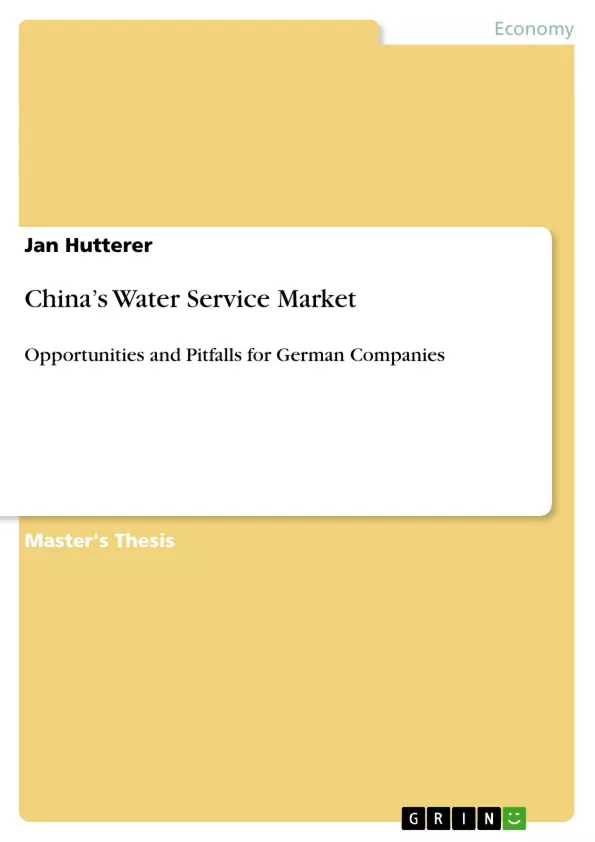Since the beginning of the “Open-Door-Policy”, China has scored remarkable achievements. Its GDP has grown from 150 billion to 1.65 trillion USD and its per capita GDP from 190 to more than 1,200 USD. However, the resources that such growth demands have raised concerns about the long-term sustainability and hidden costs of the growth. Many of these concerns are associated with the state of Chinas water resources. As demand for water has increased, so too have problems with water shortages, pollution, falling groundwater tables and flood/drought damages.
To tackle these challenges the Chinese government increasingly encourages foreign companies to engage in the Chinese water market.
Market research studies claim that this market holds promising business opportunities for both domestic and foreign companies. This thesis questions this observation from a foreign investor’s perspective. It shows that the Chinese water market indeed holds business opportunities, but that these opportunities are mainly tied to certain sectors and regions. A questionnaire carried out between foreign managers showed that these opportunities go together with high market entry barriers and high market risks. Therefore, this thesis pays special attention to potential risk treatment measures which take the position of foreign companies and the special characteristics
of the Chinese water market into account.
The paper contains six chapters. After an analysis of the business environment of the Chinese water service market, the thesis describes business opportunities for foreign companies. Afterwards potential risks for foreign investors are discussed and measures for a strategic risk treatment introduced.
Inhaltsverzeichnis (Table of Contents)
- Introduction
- Literature review
- Business environment of the Chinese water service market
- Market definition
- Dynamic development of the Chinese water service market
- Political Development
- Economic development
- Social development
- Technological development
- Legal development
- Ecological development
- Competitive situation and rivalry
- Firm strategy, structure and rivalry
- Demand conditions
- Related and supporting industries
- Factor conditions
- Summary
- Business opportunities for foreign companies
- Market segmentation
- Business opportunities in selected water service sectors
- Water treatment
- Water supply and distribution
- Maintenance and repair
- Disposal of sewage sludge
- Seawater desalination
- Consulting services
- Participation opportunities in selected public projects
- Nanshui-Beidao (South-North water rerouting project)
- Protection of important river, lake and water reservoir areas
- Water saving and water management projects
- Ecological sewage water and sanitary projects
- Risk management for foreign investors
- Risk identification and assessment
- Risks checking and analysis
- Water price development
- "Take or pay" versus "fixed return"
- Government's breach of faith
- Competitive bidding procedure
- Loan term limitations
- Land use rights
- Recommendations for potential risk treatment
- Estimate the competitive situation
- Aim for mutual benefits
- Pick winnable battles
- Build up a polychronic planning system
- Secure information flow
- Attain strategic advantages
- Marshal adequate resources
- Lean winning ways
- Summary
Zielsetzung und Themenschwerpunkte (Objectives and Key Themes)
The goal of this study is to analyze the potential opportunities and risks for German companies seeking to enter the Chinese water service market. The text examines the current market environment, identifies key opportunities for foreign investors, and analyzes potential risks associated with these opportunities. It offers recommendations for German companies to effectively navigate this complex market.
- The dynamic development of the Chinese water service market
- The competitive landscape of the Chinese water service market
- Business opportunities for foreign companies in the Chinese water service market
- Risk assessment and mitigation strategies for foreign investors in the Chinese water service market
- Recommendations for German companies seeking to enter the Chinese water service market
Zusammenfassung der Kapitel (Chapter Summaries)
The study begins with an introduction to the Chinese water service market, followed by a review of relevant literature. Chapter 3 provides a detailed analysis of the business environment of the Chinese water service market, encompassing political, economic, social, technological, legal, and ecological factors. It delves into the competitive situation and rivalry within the market, examining factors such as firm strategy, demand conditions, and related industries. Chapter 4 explores business opportunities for foreign companies, focusing on market segmentation and specific opportunities in various water service sectors. This chapter also examines participation opportunities in selected public projects. Finally, Chapter 5 focuses on risk management for foreign investors, covering risk identification, assessment, and analysis, along with recommendations for potential risk treatment.
Schlüsselwörter (Keywords)
The key focus of this study revolves around the Chinese water service market, encompassing concepts like market opportunities, business strategies, risk analysis, foreign investment, political and economic factors, competitive analysis, water treatment, water supply, and water management. The analysis is relevant for German companies seeking to expand into the Chinese market, providing insights into the complex dynamics of this sector.
- Quote paper
- Jan Hutterer (Author), 2007, China’s Water Service Market, Munich, GRIN Verlag, https://www.grin.com/document/84521



